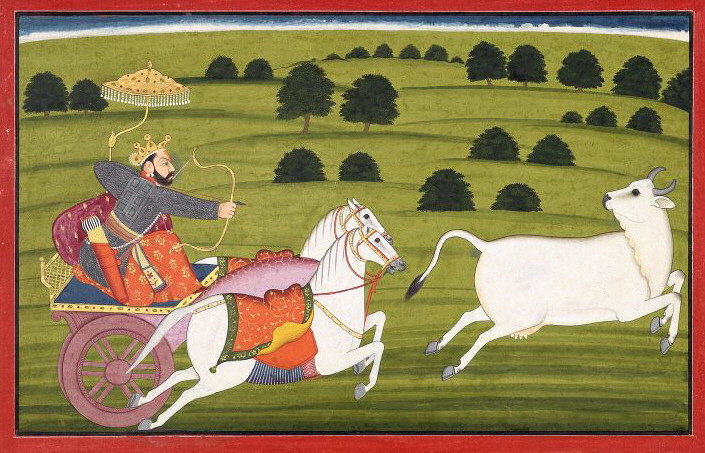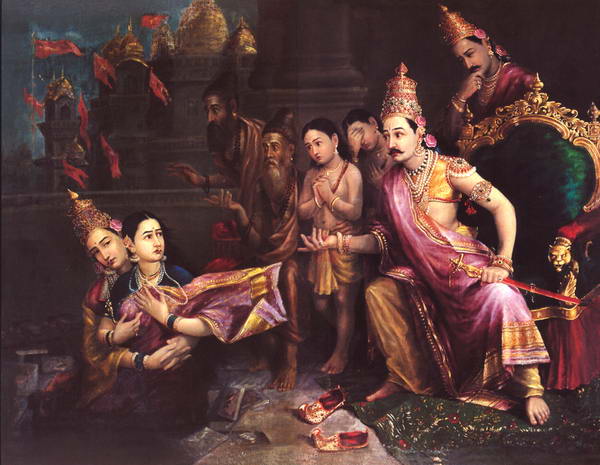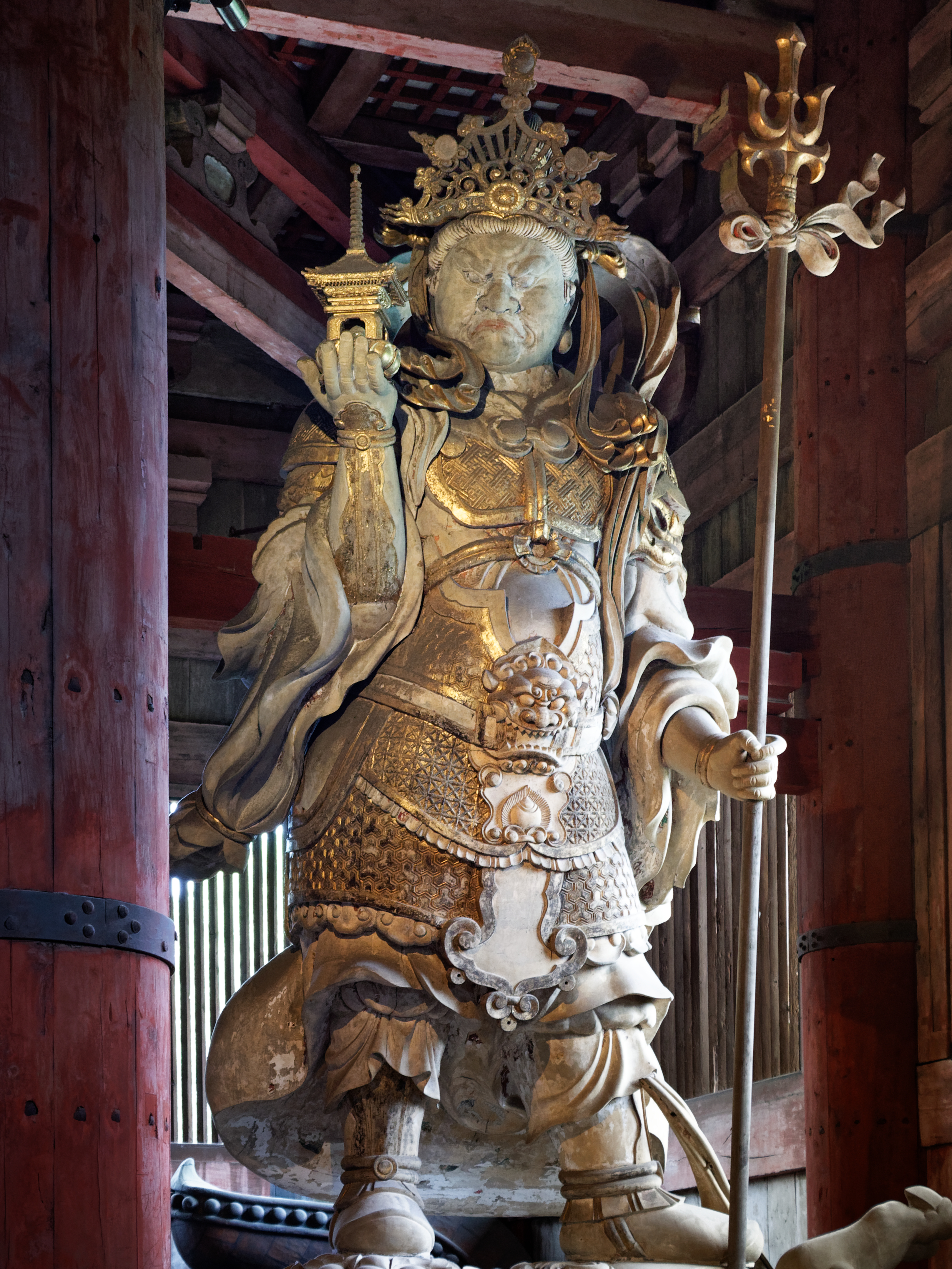|
Prithvi
Prithvi (Sanskrit: पृथ्वी, ', also पृथिवी, ', "the Vast One", also rendered Pṛthvī Mātā), is the Sanskrit name for the earth, as well as the name of the goddess-personification of it in Hinduism. The goddess Prithvi is an archetypal Mother Goddess, and one of the most important goddesses in the historical Vedic religion. She is depicted as a stable, fertile, and benevolent presence in the Vedas. She is frequently addressed as a mother, and a nurturing, generous goddess who provides sustenance to all beings living on her vast, firm expanse. While the ''Rigveda'' predominantly associates her with Dyaus ('Father Sky'), the ''Atharvaveda'' and later texts portray her as an independent deity. In classical Hinduism, the figure of Prithvi is supplanted by the goddess Bhumi, while the term Prithvi serves as one of her epithets. She becomes significantly associated with Vishnu, one of the most important gods in later Hinduism, and his avatars—Varaha ... [...More Info...] [...Related Items...] OR: [Wikipedia] [Google] [Baidu] |
Prithu - Crop
Prithu (Sanskrit: पृथु, ''Pṛthu'', lit. "large, great, important, abundant") is a sovereign ( chakravarti), featured in the Puranas. According to Hinduism, he is an avatar (incarnation) of the preserver god—Vishnu. He is also called Prithu, Prithi and Prithvi Vainya, literally, "Prithu — the son of Vena". Prithu is "celebrated as the first consecrated king, from whom the earth received her (Sanskrit) name, Prithvi." He is mainly associated with the legend of his chasing the earth goddess, Prithvi, who fled in the form of a cow and eventually agreed to yield her milk as the world's grain and vegetation. The epic Mahabharata, Vishnu Purana, and the Bhagavata Purana describe him as a part-avatar (incarnation) of Vishnu.Singh p.1713 Legends The birth of Prithu is without female reproduction. Thus being a ''ayonija'' ("born without (the participation) of the yoni"), Prithu is untouched by desire and ego and can thus control his senses to rule with dharma. ... [...More Info...] [...Related Items...] OR: [Wikipedia] [Google] [Baidu] |
Dyaus
Dyaus (Vedic Sanskrit: द्यौस्, ) or Dyauspitr (Vedic Sanskrit: द्यौष्पितृ, ) is the Rigvedic sky deity. His consort is Prthvi, the earth goddess, and together they are the archetypal parents in the Rigveda. Nomenclature stems from Proto-Indo-Iranian ''*dyā́wš'', from the Proto-Indo-European (PIE) daylight-sky god , and is cognate with the Greek Διας – ''Zeus Patēr'', Illyrian '' Dei-pátrous'', and Latin ''Jupiter'' (from Old Latin Dies piter ''Djous patēr''), stemming from the PIE ''Dyḗus ph₂tḗr'' ("Daylight-sky Father").' The noun (when used without the 'father') refers to the daylight sky, and occurs frequently in the Rigveda, as an entity. The sky in Vedic writing was described as rising in three tiers, , , and or . Literature Dyáuṣ Pitṛ́ appears in hymns with Prithvi Mata 'Mother Earth' in the ancient Vedic scriptures of Hinduism. In the Ṛg·veda, ''Dyáuṣ Pitṛ́'' appears in verses 1.89.4, 1.90 ... [...More Info...] [...Related Items...] OR: [Wikipedia] [Google] [Baidu] |
Bhūmi
Bhumi (Sanskrit: भूमि, romanized: Bhūmi), also known as Bhudevi, Dharani, and Vasundhara, is a significant goddess in Hinduism, personifying the Earth. Her earliest form is reflected in the Vedic goddess Prithvi, though their roles and depictions are drastically different. Bhumi features prominently in the ''Mahabharata'' and various Puranas. According to Vaishnava tradition, she is the second consort of Vishnu, along with Sridevi and Niladevi. As per Hindu mythology, Varaha, the third avatar of Vishnu, saved her from the asura Hiranyaksha and later married her, making her one of his consorts. After this rescue, Varaha and Bhumi have a son named Mangala. Bhumi also bears Narakasura, an asura, due to Hiranyaksha's influence. In the epic ''Ramayana'', she is mentioned as the mother of Sita, the epic's female protagonist. Bhumi is described to be born as Satyabhama, the consort of Krishna, to assist in slaying Narakasura. The Alvar saint Andal is also considered an av ... [...More Info...] [...Related Items...] OR: [Wikipedia] [Google] [Baidu] |
Sanskrit
Sanskrit (; stem form ; nominal singular , ,) is a classical language belonging to the Indo-Aryan languages, Indo-Aryan branch of the Indo-European languages. It arose in northwest South Asia after its predecessor languages had Trans-cultural diffusion, diffused there from the northwest in the late Bronze Age#South Asia, Bronze Age. Sanskrit is the sacred language of Hinduism, the language of classical Hindu philosophy, and of historical texts of Buddhism and Jainism. It was a lingua franca, link language in ancient and medieval South Asia, and upon transmission of Hindu and Buddhist culture to Southeast Asia, East Asia and Central Asia in the early medieval era, it became a language of religion and high culture, and of the political elites in some of these regions. As a result, Sanskrit had a lasting effect on the languages of South Asia, Southeast Asia and East Asia, especially in their formal and learned vocabularies. Sanskrit generally connotes several Indo-Aryan languages# ... [...More Info...] [...Related Items...] OR: [Wikipedia] [Google] [Baidu] |
Thirty-three Gods
The Thirty-three gods, or Tridasha (), is a pantheon (gods), pantheon of Hindu deities of the current ''manvantara''.Mani pp. 654–5 The ''Samhitas'', which are the oldest layer of text in the Vedas, enumerate 33 deities classified as ''Deva (Hinduism), Devas'', either 11 each for the Trailokya, three worlds, or as 12 Adityas, 11 Rudras, eight Vasus and two Ashvins in the Brahmanas.George Williams (2008), A Handbook of Hindu Mythology, Oxford University Press, , pp. 90, 112Monier Monier-Williams, A Sanskrit-English Dictionary" Etymologically and Philologically Arranged to cognate Indo-European Languages, Motilal Banarsidass, p. 492 List The thirty-three deities are: * Eight Vasus (deities of material elements) – Dyaus (sky), Prithvi (earth), Vayu (wind), Agni (fire), Nakshatra (stars), Varuna (water), Surya (sun), Chandra (moon) * Twelve Ādityas, Adityas (personified deities) – Indra (Shakra), Aryaman, Tvashtr, Varuna, Bhaga, Savitr, Vivasvan, Vivasvat, Amsha, Mitra (Ved ... [...More Info...] [...Related Items...] OR: [Wikipedia] [Google] [Baidu] |
Rigvedic Deities
Rigvedic deities are deities mentioned in the sacred texts of Rigveda, the principal text of the historical Vedic religion of the Vedic period (1500–500 BCE). There are 1,028 hymns (sūkta) in the Rigveda. Most of these hymns are dedicated to specific deities. The most prominent deity is Indra, the sky god and also the king of the gods ruler of heaven; Surya, the Sun; Agni, the sacrificial fire and messenger of the gods; and Soma, the ritual drink dedicated to Indra also related to the Moon, are additional principal deities. Deities by prominence List of Rigvedic deities by a number of dedicated hymns, after Griffith. Some dedications are to paired deities, such as Indra-Agni, Mitra-Varuna, Soma-Rudra, here counted double. Visvedevas (all gods and goddesses together) have been invoked 70 times. *Indra 250 *Agni 200 * Soma 123 * Ashvinas 56 *Varuna 46 * Maruts 38 *Mitra 28 * Ushas 21 *Vayu 12 *Savitr 11 * Ribhus 11 * Pushan 10 * Apris 9 * Brihaspati 8 *Surya 8 *Dyaus and ... [...More Info...] [...Related Items...] OR: [Wikipedia] [Google] [Baidu] |
Historical Vedic Religion
The historical Vedic religion, also called Vedism or Brahmanism, and sometimes ancient Hinduism or Vedic Hinduism, constituted the religious ideas and practices prevalent amongst some of the Indo-Aryan peoples of the northwest Indian subcontinent (Punjab and the western Ganges plain) during the Vedic period ( 1500–500 BCE). These ideas and practices are found in the Vedic texts, and some Vedic rituals are still practised today. The Vedic religion is one of the major traditions which Origins of Hinduism, shaped modern Hinduism, though present-day Hinduism is significantly different from the historical Vedic religion. The Vedic religion has roots in the Indo-Iranians, Indo-Iranian culture and religion of the Sintashta culture, Sintashta ( 2200–1750 BCE) and Andronovo culture, Andronovo ( 2000–1150 BCE) cultures of Eurasian Steppe. This Indo-Iranian religion borrowed "distinctive religious beliefs and practices" from the non-Indo-Aryan Bactria–Margiana Archaeological Compl ... [...More Info...] [...Related Items...] OR: [Wikipedia] [Google] [Baidu] |
Buddhist Pantheon
Buddhism includes a wide array of Deity, divine beings that are venerated in various ritual and popular contexts. Initially they included mainly Indian figures such as Deva (Buddhism), devas, asuras and yakshas, but later came to include other Asian spirits and local gods (like the Burmese Nat (deity), ''nats'' and the Japanese ''kami''). They range from enlightened Buddhahood, Buddhas to regional spirits adopted by Buddhists or practiced on the margins of the religion. Buddhists later also came to incorporate aspects from the countries to which it spread. As such, it includes many aspects taken from other mythologies of those cultures. Buddhas A Buddhahood, Buddha is a being who is fully Bodhi, awakened and has fully comprehended the Four Noble Truths. In the Theravada tradition, while there is a list of acknowledged past Buddhas, the historical Buddha Sakyamuni is the only Buddha of our current era and is generally not seen as accessible or as existing in some higher pla ... [...More Info...] [...Related Items...] OR: [Wikipedia] [Google] [Baidu] |
Buddha
Siddhartha Gautama, most commonly referred to as the Buddha (),* * * was a wandering ascetic and religious teacher who lived in South Asia during the 6th or 5th century BCE and founded Buddhism. According to Buddhist legends, he was born in Lumbini, in what is now Nepal, to royal parents of the Shakya clan, but renounced his home life to live as a wandering ascetic. After leading a life of mendicancy, asceticism, and meditation, he attained nirvana at Bodh Gayā in what is now India. The Buddha then wandered through the lower Indo-Gangetic Plain, teaching and building a monastic order. Buddhist tradition holds he died in Kushinagar and reached ''parinirvana'' ("final release from conditioned existence"). According to Buddhist tradition, the Buddha taught a Middle Way between sensual indulgence and severe asceticism, leading to freedom from ignorance, craving, rebirth, and suffering. His core teachings are summarized in the Four Noble Truths and the Noble Ei ... [...More Info...] [...Related Items...] OR: [Wikipedia] [Google] [Baidu] |
Ushas
Ushas (Vedic Sanskrit: , , nominative singular उषास्) is a Vedic goddess of dawn in Hinduism. She repeatedly appears in the Rigvedic hymns, states David Kinsley, where she is "consistently identified with dawn, revealing herself with the daily coming of light to the world, driving away oppressive darkness, chasing away evil demons, rousing all life, setting all things in motion, sending everyone off to do their duties". She is the life of all living creatures, the impeller of action and breath, the foe of chaos and confusion, the auspicious arouser of cosmic and moral order called the Ṛta in Hinduism. Ushas is the most exalted goddess in the ''Rig Veda'', but not as important or central as the three male Vedic deities Agni, Soma, and Indra. She is on par with other major male Vedic deities. She is portrayed as a beautifully adorned young woman riding in a golden chariot or a hundred chariots, drawn by golden red horses or cows, on her path across the sky, making wa ... [...More Info...] [...Related Items...] OR: [Wikipedia] [Google] [Baidu] |
Varaha
Varaha (, , "boar") is the avatar of the Hinduism, Hindu god Vishnu, in the form of a wild boar, boar. Varaha is generally listed as third in the Dashavatara, the ten principal avatars of Vishnu. In legend, when the demon Hiranyaksha steals the earth goddess Bhumi (goddess), Bhumi and hid her in the primordial waters, Vishnu appears as Varaha to rescue her. Varaha kills Hiranyaksha and retrieves the earth from the cosmic ocean, lifting her on his tusks, and restores her to her place in the universe. Varaha is depicted as a boar or in an anthropomorphic form, with a boar's head and the human body. Varaha often depicted lifing his consort Bhumi, the earth. Etymology and other names The deity Varaha derives its name from the Sanskrit word ''varaha'' (Devanagari: वराह, ) meaning "boar" or "wild boar". The word ''varāha'' is from Proto-Indo-Iranian language, Proto-Indo-Iranian term ''warāȷ́ʰá'', meaning boar. It is thus related to Avestan ''varāza'', Kurdish lan ... [...More Info...] [...Related Items...] OR: [Wikipedia] [Google] [Baidu] |




